
Muscular Dystrophy Australia Year in review 2020
“I often talk about the MDA ‘community’. This year you have shown us what a caring, strong and determined community you are. The collective power of so many people united to offer support and hope to those living with neuromuscular diseases makes a huge difference.”
- Anne Rogers
Message from the CEO
Page 5
Covid Survey Results
Page 6
Chris Fairall Grant
Page 8 World Duchenne Awareness Day Page11
Client Services
Page 12
Research Page 27
Strategic plan summary
Page 32
Fundraising Page 18
Living with Myotonic Dystrophy
Page 29
Financial information
Page 34

4 M ESSAGE FROM T h E CEO
JAN CHISHOLM
2020 was a challenging year for everyone in all corners of the world. We are immensely grateful for the trust our community showed us and for expressing from the start that one of their most important needs was to have a human connection and regular interactions with us.
Message from the CEO
This need was especially challenging to meet during the pandemic and we required new technology and equipment to support our community during and after the pandemic.
One of the projects that inspired us was the development and delivery of Connecting Care - a program dedicated to online support groups where people living with neuromuscular diseases could connect and meet each other.
We launched a COVID-19 Survey to identify our community’s needs, which included: a mental health service made available specifically to people with neuromuscular diseases and their families and that service organisations continue to check in on the health and wellbeing of their members using a variety of communication tools and online social groups. More details about the survey results can be found in this report.
In difficult circumstances, unsung heroes come to the fore and we were ecstatic to receive a $10,000
grant from the Commbank Staff Foundation.
More heroes emerged in our national campaign ‘Superhero Week’ where we received amazing support from PJ Masks.
We were proud to participate in World Duchenne Awareness Day and share some of our clients’ voices.
It is fair to say that pandemic or not, your voice is becoming stronger and we thank you for allowing us to be your sounding board.
Our thanks in particular to our volunteer Committee of Management, whose leadership and support was invaluable during this past year:
Anne Rogers (President), Jason White (Vice President), Rosemary McKenzie (Treasurer), Dennis Delaney, Kevin Fryer, Chriss Mannix, Boris Struk.
Jan Chisholm CEO
5 M ESSAGE FROM T h E CEO
COVID-19 being the force that shaped 2020 for so many of us, we joined forces with a group of state-based Australian organisations dedicated to people with muscular dystrophy and similar diseases.
Covid Survey Results
Together, we developed and disseminated a survey to better understand the community’s experience living with a neuromuscular disease during COVID-19.
We sent the survey to 350 MDA clients and also shared it on various social media platforms including our website.
The results showed that while people living with neuromuscular diseases faced similar emotional and isolation challenges related to COVID-19 to the general public, they felt a greater impact in relation to mental health. This included a general deterioration in mental health in broad terms due to a variety of COVID-19 factors
such as feelings of anxiousness, disappointment and rising frustration.
The results will help us strengthen advocacy to federal, state and local government agencies for people living with a neuromuscular disease. They will also help guide our services for clients, including:
• prioritise particularly vulnerable groups, including our older clients or those we know live alone.
• focus on welfare calls and initiate our ‘Connecting Care Program’
The results of the survey were made available here.

CO v ID Su R v EY R ES u LTS 6
Four areas needing action
Mental health service
A mental health service be made available specifically to people with neuromuscular diseases and their families
Awareness
An awareness campaign be created to promote any existing services that support the mental health of people with neuromuscular diseases
PPE supply
Service organisations organise the direct supply of personal protective equipment and help facilitate food delivery services; and
Communication
Service organisations continue to check in on the health and wellbeing of their members using a variety of communication tools and online social groups
“he’s really appreciative that MDA checks in on him and other clients.”
CO v ID Su R v EY R ES u LTS 7
In September 2020, we were privileged and humbled to receive a grant of $10,000 from the Commbank Staff Foundation.
Chris Fairall Grant
The grant meant we were able to trial our Connecting Care program and establish video support groups, information sessions and updates to meet up with our community across Australia.
We’re immensely grateful to Amy Bourke, a Commbank team member, who nominated us. Amy has worked for Commbank for over seven years in customer care and is now Assistant Manager in her local branch.
When the grant opportunity was announced earlier in the year, Amy immediately knew which cause she wanted to nominate.
‘In the past we’ve been able to nominate community groups in our area or local schools. This year because of the coronavirus situation we were able to nominate any cause close to our heart.
I chose MDA because of my cousin, Christopher, who had Muscular Dystrophy.
Chris was born a year before me, so we grew up together.
My sister and I spent a lot of time with Chris, particularly playing video games which was his passion. Even in later years when only his thumbs were mobile, he could still play the games he enjoyed so much. We’d have pizza and Xbox nights where we’d play together for hours at a time.’
Sadly, Chris died at age 28. Thinking of him now, Amy says:
‘Chris would have loved the idea of Connecting Care. Being able to make online connections with other people in the same circumstances would have been great for him.
When I told the family about this grant, we were all so happy. I cried and cried when I heard MDA would receive this funding. My aunt, when she heard about it, said Chris would have been so excited and shouting “Hell, yeah!”’
“having a way to connect with others who know what they are going through will make a huge difference.”
Ch RIS FAIRALL G RA n T 8
Amy has personally supported MDA for many years, sharing our social media posts and buying tickets in the Harley Davidson raffles.
‘I may not have $10,000 to donate myself but I’m so happy to support what you do. Connecting Care will be an amazing project.
People living with MD can’t always just walk out the door and meet people. Having a way to connect with others who know what they are going through will make a huge difference.’
As Amy summed it up so eloquently ‘Lots of people in Australia don’t know what MD is. I was blown away when I heard this grant had come through. I knew it meant MDA’s work for people with muscular dystrophy could get the spotlight and other people can see just how important it is.’
We are ever so grateful to Amy and Commbank Staff Foundation, for believing in what we do.

“Being able to make online connections with other people in the same circumstances would have been great for Chris.”
Ch RIS FAIRALL G RA n T 9
CHRIS FAIRALL
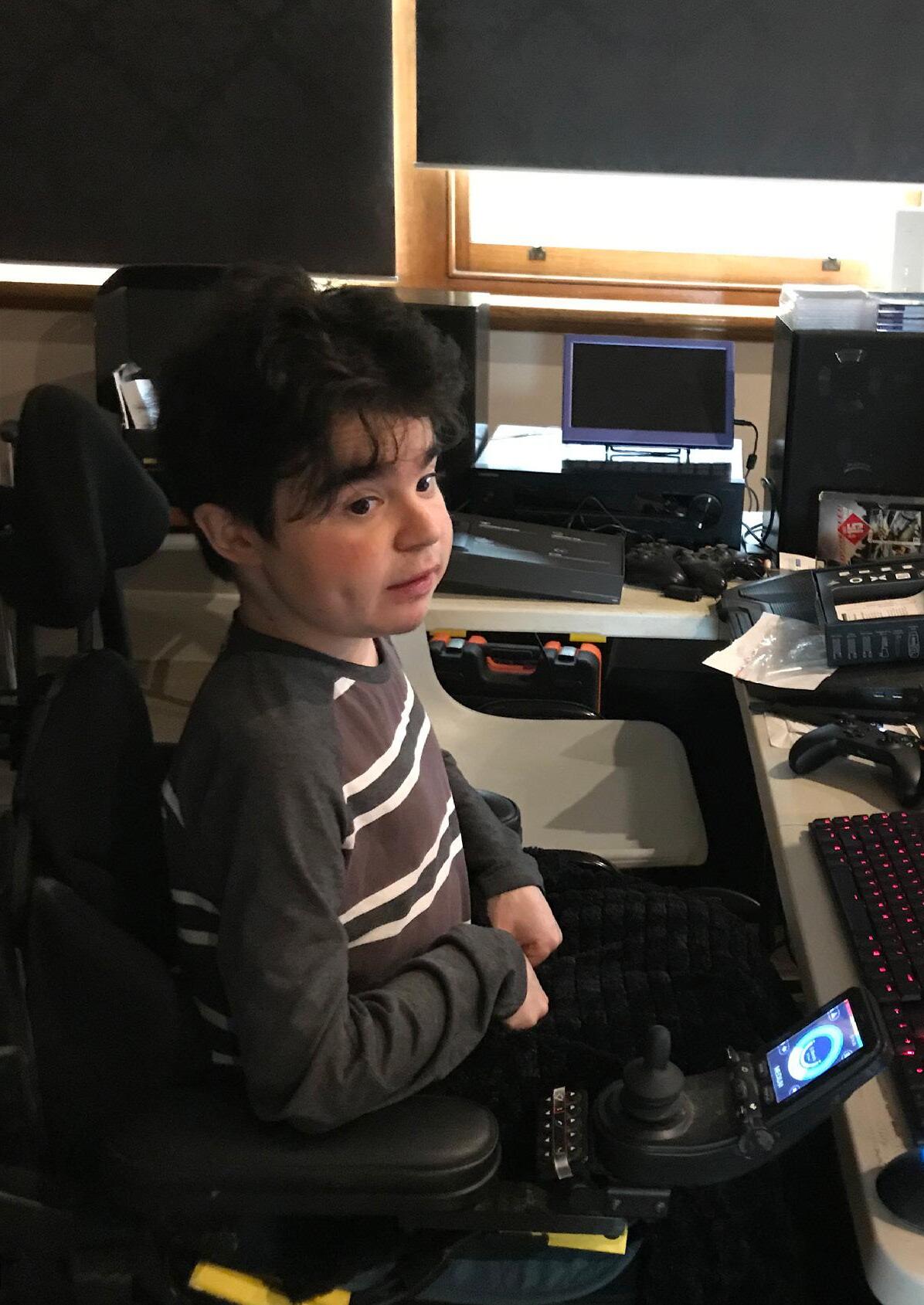
W ORLD Du C h E nn E AWARE n ESS D AY (WDAD) 10
GEORGE HEARD
World Duchenne Awareness Day
(WDAD)
On 7 September 2020, MDA proudly participated in the World Duchenne Awareness Day campaign (WDAD). A day dedicated to raise awareness about Duchenne and Becker muscular dystrophy (DMD & BMD).
The announcement garnered unprecedented social media engagement and was enthusiastically welcomed by our community.
Events were organised in more than 50 countries. We shared a couple of MDA clients’ stories and one of them was George Heard’s.
World Duchenne Day - George’s Story
I am George Heard, 22 years old. I was diagnosed with Duchenne muscular dystrophy when I was 3. I have four older sisters, two nephews and two nieces.
I live with my parents on our farm near Willaura, a small country town in the Western District of Victoria. We farm merino sheep for wool and we grow crops.
I went to the local kindergarten and the primary school and then went to secondary school in Ararat, a larger town 43km away.
My hobbies and interests are computers. I fix up old computers and sell them on eBay. I do computer upgrades and repairs. I also enjoy keeping up with current affairs.
To relax, I like to play computer games, mainly Minecraft and car racing. I also like to watch Linus Tech Tip, Mighty Car Mods and other YouTube channels, mainly about cars and computers.
Facebook is good to keep up with my friends and family, as well as posting items of my own.
I also keep Mum and Dad entertained with all my knowledge and political views!
All in all, life is OK except for the COVID-19 pandemic – when it will end and how it is affecting everyone.
Muscular Dystrophy Australia has supported me from the time of my diagnosis. I live about 250km from Melbourne, but this doesn’t matter. MDA is only a phone call away. MDA provided contact at the Royal Children’s Hospital with a wonderful specialised nurse, Dani, who made things so easy for the whole family.
I am very interested in the history of Duchenne muscular dystrophy and its discoverer Guillaume Duchenne.
Treatments for MD have improved in the years since my diagnosis. Life expectancy then was until late teens and early twenties. Nowadays I am hearing of people living until 50.
MDA keeps me up to date with the latest research and developments in MD, which I hope may lead to even better results.
By
George Heard, 7 September 2020
“MDA has supported me from the time of my diagnosis. I live about 250km away from Melbourne, but this doesn’t matter. MDA is only a phone call away.”
W ORLD Du C h E nn E AWARE n ESS D AY (WDAD) 11
Client Services
Snapshot report
Myotonic Dystrophy
Duchenne Muscular Dystrophy
Inclusion body myositis (IBM)
Limb–girdle muscular dystrophy (LGMD) Myopathy
Unknown
Facio scapulo humeral (FSH)
Myositis
Oculopharyngeal
Gravis
Myopathy McArdle disease
Muscular Dystrophy
In 2020, MDA welcomed 51 new clients. Throughout the year we were proud to offer support to a total of 1109 clients living with a range of neuromuscular diseases.
The new clients who joined our community in 2020 are living with the following diseases.
“Thank you very much, I appreciate everything you do.”
C LIE n T S ER v ICES 12
Becker
Bethlem
Charcot- Marie-Tooth 12 6 5 4 4 4 2 2 2 1 1 1 1 1 5
Myasthenia
Myotubular
Myopathy
State by State incoming clients
Currently, we support 1109 clients.
C LIE n T S ER v ICES 13 VIC - 38 Overseas - 3 NSW - 2 QLD - 2 SA - 2 TAS - 2 WA - 2 ACT - 0 NT - 0 VIC - 882 NSW - 92 QLD - 55 TAS - 27 WA - 26 Overseas - 12 SA - 8 ACT - 6 NT - 1

C LIE n T S ER v ICES 14
how COvID-19 changed our landscape
COVID-19 dramatically changed our landscape and made us look at new ways of operating and connecting with our clients, their families and their carers. Like everyone else in the world, we had to adapt and were lucky to be able to work remotely.
One-on-one contact calls were prioritized and we were able to send complimentary magazines to our most isolated clients to help them pass the time.
Despite having to work from home, our Client Services Team was able to support our clients with additional welfare calls. We were committed to deliver the requested information in a timely manner.
Our contact calls took on a very different approach. In many cases we were the only connection with the outside world and more clients took the opportunity to enquire about our services and equipment. They told us the phone conversations made their day easier. The phone became a lifeline.
Our phone calls helped bring our clients’ main concerns to light, including:
• Their frustration with the lack of knowledge that some of their NDIS Support Coordinators have
• The time taken to implement changes to plans
• The lack of community supports available during lock down periods
• Their GPs not really knowing about their disease
• The feeling of being invisible, not being taken seriously and understood
• They often told us we were the first person to ask relevant questions and who had an understanding and an idea as to what the next step should be
As a result, our client services team prioritized the following five areas.
“Thank you for such an amazing service that I was able to reach out to.”
C LIE n T S ER v ICES 15
Our priority client service areas
navigating nDIS
Help clients get the most from their plans.
Social contact
This was done mainly by phone. All other information was disseminated electronically on websites and various social media platforms.
Equipment and accessibility supports
We were lucky and grateful to receive many equipment donations. Notably, Variety Australia, who donated to us an all-terrain beach wheelchair. We are in the process of improving our equipment library booking system.
Connections, information and referral
It became more obvious at the start of the pandemic that connections, information and referral is our core service. We are the one-stop-shop for anyone seeking trusted advice, information and connections in relation to their neuromuscular disease. While being primarily phone based, we were able to identify ways that would help us deliver even better connections, through Zoom meetings for example.
Respite
There weren’t any opportunities for respite during 2020 due to Covid but at the end of 2020 our Client Services Team started investigating and planning for the future. We identified the need to resurrect social weekends and activities for all ages.
C LIE n T S ER v ICES 16

Fortunately, our MD community came through the COvID-19 pandemic relatively unscathed and remained positive.
Unsung heroes donated their time and skills to support our community, in the shape of generous volunteers who knitted and crocheted rugs for our wheelchair clients. And the Rotary Club Essendon who donated bottles of Hand Sanitiser for our use and to distribute to our clients where needed.
C LIE n T S ER v ICES 17
More than 60% of our income comes from fundraising and we simply couldn’t carry out our services and fund research without the support of our community.
COVID-19 and findings from our Client Services Team about our clients’ needs were huge drivers in developing some of our fundraising activities and goals.
Fundraising
We launched several appeals and a new initiative: Containers for Change.
One of our appeals was the COvID-19 urgent Appeal.
At the start of the pandemic our community was identified as being at higher risk of respiratory distress and more susceptible to heart complications should they become infected.
We followed government advice and were proactive in putting strict measures in place to protect our clients and staff.
New interventions and more online and phone support to guide families through these tough times meant we needed financial help to fund new communications equipment.
Thank you to everyone who donated to our appeals. Your generosity directly allowed us to achieve more and expand our services.
Two examples of such projects included:
• The Connecting Care Project to help connect people and
• The Christmas Appeal to support important research
Why we need to connect
The Connecting Care Program will help many of our clients living with muscular dystrophy. Clients, who are unable to attend their usual support networks and are feeling increasingly isolated even after lockdown.
Until the vaccine has been rolled out we err on the side of caution and though we are not currently in lockdown, we can see the benefit of rolling out more online support to connect with our clients in remote and regional areas of Australia. Connecting by audio visual means makes it more personal and less lonely.
Thank you to everyone who donated to our appeals. Your generosity directly allowed us to achieve more and expand our services.
Fun DRAISI n G 18
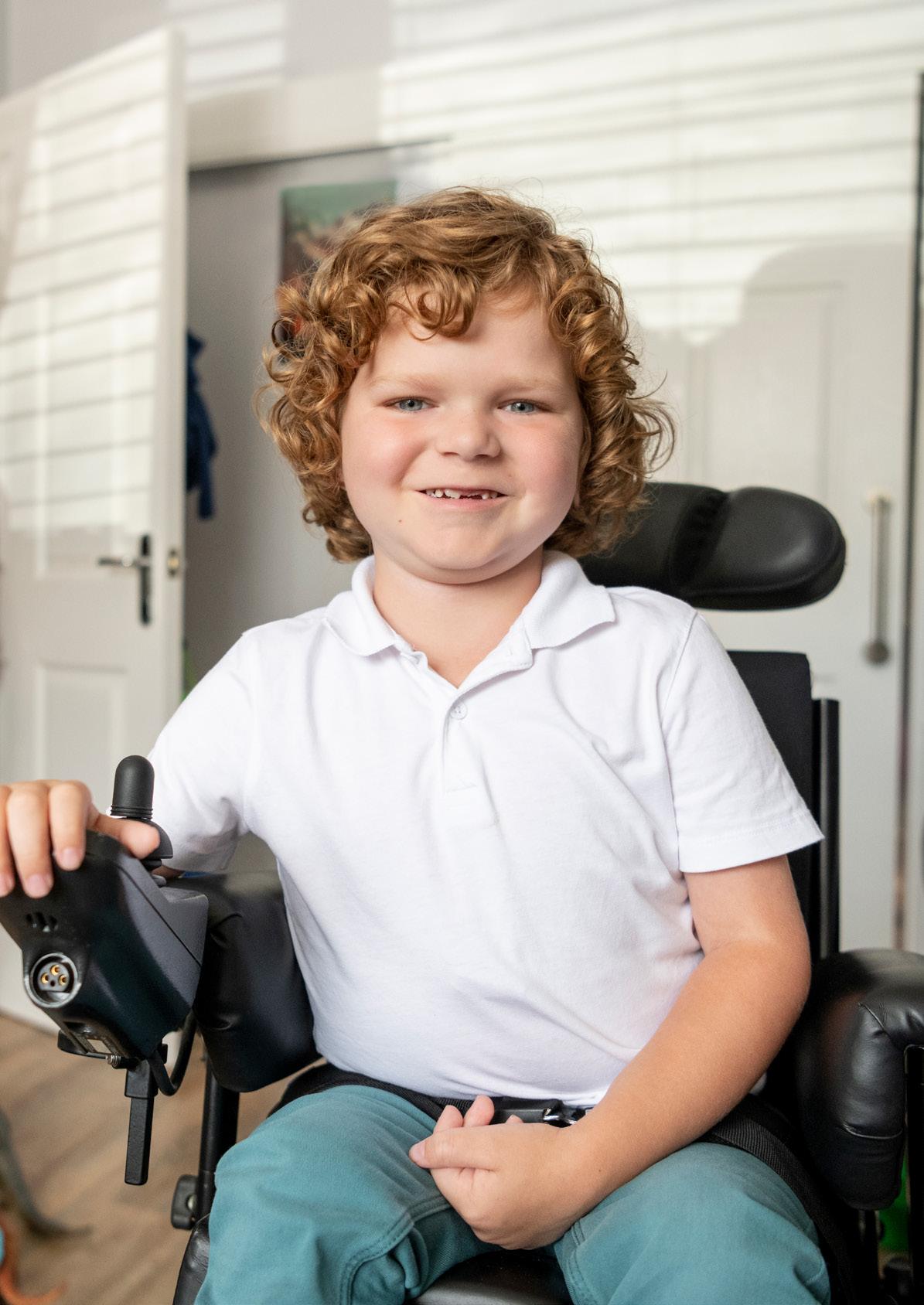
Fun DRAISI n G 19
Containers for change
2020 saw us participate in an innovative and amazing initiative ‘Containers for Change’, where recyclable containers in caravan parks are recycled while supporting us. People reduce their environmental impact by ensuring containers are properly recycled as well as raise funds for muscular dystrophy - rubbish turns into a gift for us and the environment. containersforchange.com.au/
It all started when Tony contacted MDA to see if we’d be interested in participating in the unusual fundraising.
Tony and his wife Patsy moved to Western Australia from the UK a few years ago so that they could be near their son and his family, and help with childcare.
Coincidently, Tony worked for an Australian bank in London for many years. He and his wife now live in a friendly caravan park near the sea. They started to recycle everything they could and introducing Containers for Change helped motivate residents to recycle too.

Currently, they collect in excess of $100 per month for their chosen charity.
“Two people, who all residents of our Park know well, have muscular dystrophy. Residents felt that this charity was therefore the logical choice. I contacted MDA, who embraced the idea of Containers for Change (CfC) being a valid income stream and soon set it all up,” says Tony.
“About 80% of residents, many of them in their 80s and 90s now recycle. Some needed a bit of encouragement and the idea of donating to a relevant charity really helped. Apart from the very obvious messages of “save the planet” and “cure/prevent Muscular Dystrophy”, I’d like to add that these things are not difficult to set up and maintain if you show a bit of enthusiasm and most things can be done if you try hard enough,” concludes Tony.
Fun DRAISI n G 20
CONTAINERS FOR CHANGE DONATES REFUNDS FROM RECYCLING TO MDA.
Run for Strength 2020
For more than a decade now, we’ve held ‘Run for Strength’, an event where the Melbourne community shows support for people living with muscular dystrophy by ‘running for those who can’t’.
The inaugural Run for Strength event, first held in February 2009, was the brainchild of Ozi Akyildiz, father of Kaya who has muscular dystrophy, and his friend Sam Quattrone.
Australian television presenter Kristy Mayr and hundreds of Melbournians and interstate visitors ran and walked alongside those who couldn’t at Muscular Dystrophy Australia’s annual Run for Strength in Albert Park.
The superhero themed fun run was open to all ages and abilities and had a huge turn out with many members of the MD community, their friends and families. Including Jayden who chose to celebrate his eleventh birthday by raising funds with his mighty team: Team JayJay.
All proceeds from the day go towards programs, services and research for the Muscular Dystrophy community.

Fun DRAISI n G 21
RUN FOR STRENGTH WAS FIRST HELD IN FEBRUARY 2009.
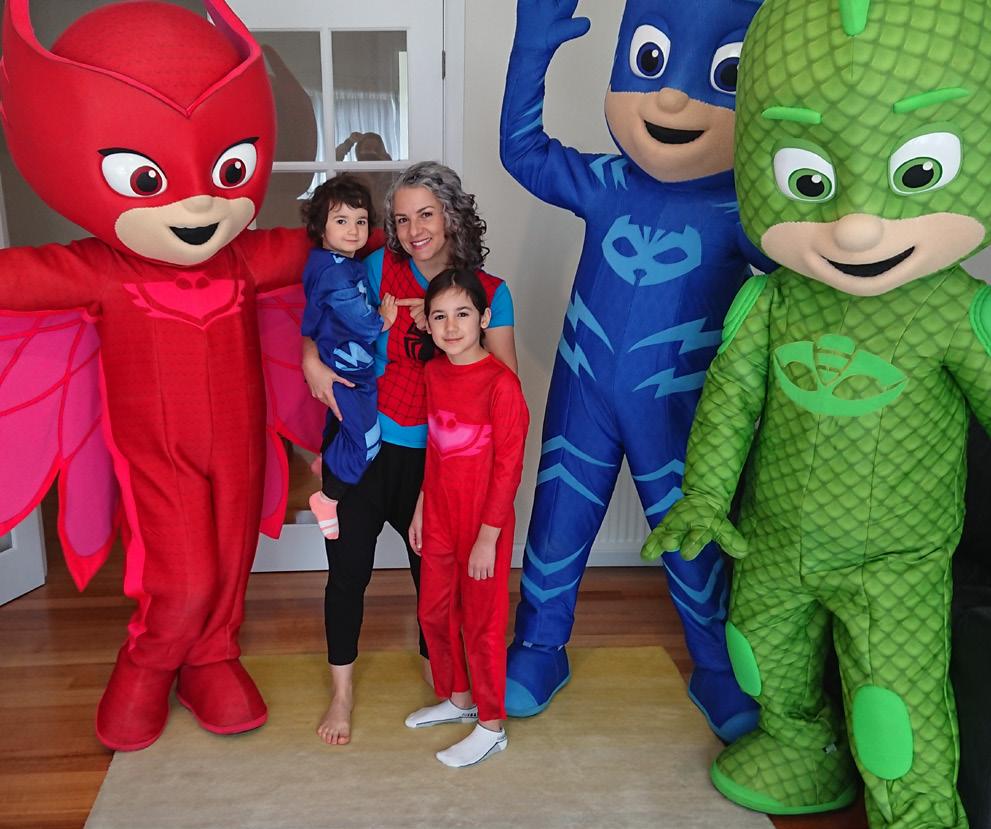

Fun DRAISI n G 22
PJ MASKS WERE OUR MAJOR SPONSOR OF NATIONAL SUPERHERO WEEK.
national Superhero Week 2020
During National Superhero Week, people hold a fundraiser for Muscular Dystrophy Australia.
Most people living with muscular dystrophy don’t like to be compared to superheroes. They are, after all, only humans trying the best they can while living with a progressive neuromuscular disease.
However, the theme ‘superhero’ started many years ago when two fathers were talking about their young sons and said that ‘they were the superheroes of their lives, battling a battle no-one should have to, especially children.’
The two boys have been honored ever since with the superhero theme for their strength of character and courage.
In 2020, we were very lucky to have PJ Masks on board as our major supporter. PJ Masks provided gifts for schools who registered their events early and organised a meet and greet with their characters to the delight of young children.
The fundraiser generated more than $20,000 and raised awareness across the nation.

Trivia night
For the first time in 2020 we held our July Trivia Night online. It was a most welcome interlude in the lives of Victorians who were experiencing the full force of a draconian lockdown that saw them separated for a long period of time from their families and friends. There were unprecedented and stressful times that saw people hunt for basics such as toilet paper and pasta in bare shopping shelves.
Nine teams participated and raised $945
The top two winning teams were clients and their families.
Fun DRAISI n G 23
harley Raffle
We run two Harley Raffles a year where we give a new Harley Davidson away.
Our most recent lucky winner for the Harley Raffle #69 was Bryan from SA.
“Got the bike delivered to me from an Adelaide Harley dealer via Morgan and Wacker last Thursday. Awesome bike, looks great and very comfortable.
Just like to thank Muscular Dystrophy Australia for the option to be able to win this bike. Also Morgan and Wacker for supplying the bike. I have been buying MDA Raffle tickets for a number of years but never imagined I could have been this lucky.
MDA is a great charity to support and a few dollars for tickets in the Harley Raffle is an easy way to support you and gives me something to dream about winning.”

“The dream came true, together with a huge shock, when notified of the win. Currently the harley is the talk amongst our riding group.”
Fun DRAISI n G 24
BRYAN FROM SA WITH HIS NEW HARLEY DAVIDSON.
“It takes significant dollars to fund labs, consumables, technicians, lab assistants and of course PhD students and Postdoctoral fellows. MDA needs the support of not only the MD Community, but the wider community to garner these essential resources to help them.”
- Associate Professor Jason White
Fun DRAISI n G 25

MDA WORKS WITH TALENTED RESEARCHERS LIKE DR CHANTAL COLES
26 R ESEARC h
Our dream here at MDA is to one day be made redundant, where there won’t be any need for a muscular dystrophy organisation, because muscular dystrophy will be curable.
Research
The cure might be many years away, but we can all play our part by helping fund the vital research that could deliver the next breakthrough.
While we support people living with muscle-wasting disorders every day, we also work with talented researchers determined to make a breakthrough in our understanding of these rare and often misunderstood diseases.
One of these researchers, Dr Chantal Coles, leads a project to ‘grow’ muscle cells out of stem cells. Being able to create new muscle cells allows the team to see exactly what happens in muscles affected by muscular dystrophy. The goal is to grow an organoid (a ‘miniorgan’). Organoids are valuable tools in medical research, enabling researchers to better study organ development, disease, and potential treatments.
MDA supports Dr Coles in her work that allows her team to model different treatments in muscles.
At the time she told me “I’m incredibly grateful to be the inaugural MDA Research Fellow, and I hope that my research can lead to meaningful outcomes for families in the future.”
MDA has been a longstanding supporter of research efforts and has funded research programs, scholarships and the purchase of important lab equipment.
In recent years, we’ve seen research deliver important new treatments that help people with muscular dystrophy hold on to their quality of life for longer. Research today can offer hope for better treatments in the short term.
We were grateful to all our donors who helped us get closer to a cure. Notably, Thysol Australia, who came onboard and made a generous donation.
“What we should keep in mind is that while a cure hasn’t been found yet, research has been the driving force in improving the quality of life of people who live with MD.”
R ESEARC h 27

28 L I v I n G WIT h M YOTO n IC DYSTROP h Y
Nerida’s experience of the journey to realising that her family was impacted by this relatively rare disease is not uncommon.
There were no definite signs that something was amiss. Myotonic Dystrophy can appear at any age and what makes it so difficult to diagnose is that every person will show different symptoms and will consequently have a different journey.
This is Nerida’s journey.
Living with Myotonic Dystrophy
Nerida’s eldest son, Marcus, 25, started showing symptoms when he was around three years old. His speech and balance were delayed. Doctors kept telling Nerida that “he’ll catch up”. But Marcus’s kindergarten teacher insisted that there was a deeper problem.
Marcus began to stutter and Nerida saw many paediatricians who assured her that Marcus would catch up.
Finally, Nerida saw a paediatrician who, unlike previous specialists, focussed on her medical history and pregnancy. In conversation with the specialist Nerida shared that her own eyesight had deteriorated. She couldn’t see certain things, like wires, white on white, etc. Her eyes were checked and Nerida found out she had cataracts, which was very unusual for a person of her age. What was even more unusual was the speed at which they had developed. The eye specialist was at a loss to explain what could have been the cause. Subsequently, Nerida, then aged 28, went to the Eye and Ear Hospital.
They operated on one eye and later on the other. The surgeon was surprised that Nerida had developed cataracts at such a young age.
When Marcus was three years old, she took him to another doctor to check about his speech delay. The paediatrician told her that Marcus either had Fragile X or Myotonic Dystrophy and conducted blood tests.
Nerida started researching both Fragile X and Myotonic Dystrophy online. She recognised some symptoms described as being common in Myotonic Dystrophy and realised that her father had shown similar symptoms. The online searches made her feel apprehensive and anxious.
One of the symptoms she recognised was problems with gallstones. Her father had problems with gallstones and Nerida had hers removed at 21.
Nerida’s blood test results confirmed that she had Myotonic Dystrophy. Nerida is only physically affected by
nerida found it comfortable and reassuring to ask MDA any questions she wanted.
L I v I n G WIT h M YOTO n IC DYSTROP h Y 29
Myotonic Dystrophy. Both her sons, Marcus and James were diagnosed with Myotonic Dystrophy.
She was too focussed on her sons to process her own diagnosis. She considered herself lucky to only have a mild form of the disease. As a mother, she was absolutely devastated to learn that her sons had Myotonic Dystrophy. She was really scared for them and their future but she found some comfort in learning that her children wouldn’t be in pain.
Her youngest son, Harris, 16 was conceived through IVF and is free from the Myotonic Dystrophy disorder.
Once Nerida’s diagnosis was confirmed, she contacted her relatives to let them know and to advise them and to get tested, especially if they were planning to have children.
A relative recommended Nerida contact MDA. She found it comforting and reassuring to be able to ask MDA any questions she wanted, particularly to get advice
“The moment you find out your children are diagnosed with Myotonic Dystrophy you will experience grief. Grief for the life you imagined and the life you think they won’t have.”
on whether what Marcus and James were going through was normal. Those discussions helped her navigate through the uncharted waters of Myotonic Dystrophy.
She found out that Speech Therapy was beneficial to Marcus who had developed a severe stutter.
James had a different experience with Myotonic Dystrophy. His time at kindy was fine. He did junior prep but that wasn’t unusual. Several other children were doing junior prep too. Teachers thought he just needed a little bit more help. At Grade One, they noticed James was learning a little more slowly. Unlike Marcus, James had no speech problems. James was tested for Myotonic Dystrophy during Grade Three.
Today, James is doing well and is undertaking a welding apprenticeship, which he enjoys. He finds maths questions challenging and carrying a scientific calculator is an effective solution. His work place has been able to accommodate some of his needs.
Nerida shares some her thoughts, which she hopes might be helpful to someone else going through a similar journey.
‘The moment you find out your children are diagnosed with Myotonic Dystrophy you will experience grief. Grief for the life you imagined and the life you think they won’t have. You will think of what could have been. You will never get over it but you will learn to live with it.’
L I v I n G WIT h M YOTO n IC DYSTROP h Y 30
‘Grief is a process. You will never cease to worry. It’s taken me ten years to be able to get a proper night sleep. I found out later it was a form of depression.’
‘For me, the main thing is that my children are not in pain.’
‘It’s taken me twelve or thirteen years to come to terms with the situation. It takes time to adjust and that’s okay. The fear of the unknown is excruciating. But the main thing parents of newly diagnosed children should remember, is that doctors will always give you the worst-case scenario. Please remember, and I cannot stress this enough. Every case is different. That’s the truth about Myotonic Dystrophy. Not one person will have the same journey.’
In the last five years, Nerida has gradually felt a change in her fitness. She feels more tired after exercising because of the muscle weakness due to the disorder.
To keep as healthy as possible, she does Pilates and walks. She can no longer go the gym. It’s too hard on her muscles.
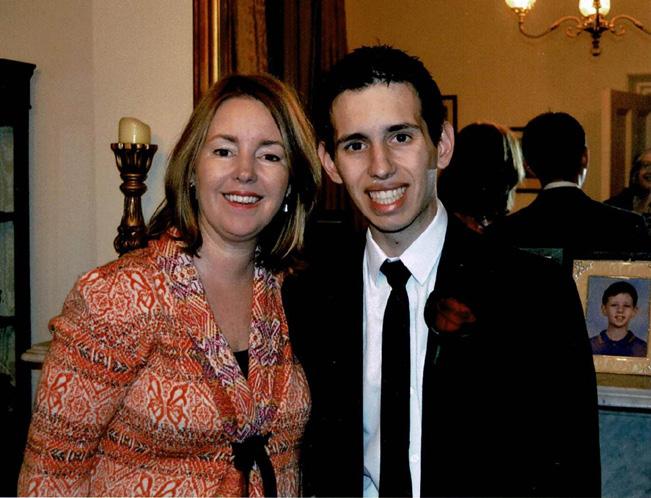
The whole family eats healthily and maintains a healthy weight, which Nerida believes is crucial to cope with the symptoms. ‘The majority of people with MD must ensure they maintain good cardio and respiratory functions to keep healthy.’
Finally, the main message that Nerida would like parents of newly diagnosed children to remember
is that Myotonic Dystrophy is not a death sentence.
‘A positive attitude helps. You will mourn and grieve, but you will learn to live with it. Stay off Dr Google! Live for today. As long as your children are happy that’s all that matters. Life goes on and family is important,’ concludes Nerida.
“As long as your children are happy that’s all that matters.”
L I v I n G WIT h M YOTO n IC DYSTROP h Y 31
NERIDA AND JAMES
MDA’s strategic plan
vision:
Mission:
Goals:
Role: A
Provide practical support and hope to the
Inputs:
S TRATEGIC PLA n S u MMARY 32
Services voice Partnerships Knowledge
People Business Systems Sustainability Outreach values Inclusive Caring Respectful Brave Determined
Working towards a world without Muscular Dystrophy
MD community
national source of informed advice, support, referrals and activities that benefit people living with MD and other muscle wasting diseases.
Goals - in detail
Services
• One-stop shop for easy access to knowledge, referrals and information for people anywhere in Australia.
• Support groups, connecting with others available to all clients via MDA virtual and inperson activities.
• Support clients to navigate the NDIS and MyAgedCare via MDA provider services
• Respite, activities and opportunities for clients to broaden their horizons
voice
• MDA as the trusted voice for our community.
• Advocacy to government in relation to supports and research.
• Supporting our community to overcome barriers to accessibility in everyday life.
Partnerships
• Partnering smartly with others - government, NFP and for profit providers to ensure the most effective service delivery for our clients.
• Corporate and NFP partnerships allow cost effective service delivery and support services.
Knowledge
• Referrers aware of MDA services and how to ensure newly diagnosed people can reach us.
• Clients informed about their disease in the format and language they choose.
• Up to date knowledge and opportunities are created and shared.
• Enabling impactful, translational research into causes, treatments and cures.
• Sharing knowledge of research initiatives worldwide and offering our community chances to be involved.
Inputs - in detail
People
• The most appropriately qualified staff and volunteers recruited, trained and supported to deliver on our promise to clients,donors, funders and stakeholders.
• Clients have a voice in our organisation’s direction, delivery and planning.
Business Systems
• Flexible systems allowing remote and flexible working and access to information
• Strong financial and HR systems underpinning sustainable business practices.
• Agile practice allows us to spot and create new opportunities to achieve our goal and mission.
Sustainability
• Government funding opportunities including cost effective delivery of NDIS provider services.
• Philanthropic, corporate, commercial and other funding sources are sustainable, appropriately resourced and overseen and offer value to both parties.
• Business planning is clear and regularly reviewed.
Outreach
• Partnerships are valued as a means of offering additional value to our clients.
• MDA is visible at all levels of health and government as a trusted source of information on MD and related neuromuscular diseases.
• Research partnerships are appropriately reviewed before being entered into and monitored for impact regularly.
• Potential clients and their families are aware of MDA and our services.
S TRATEGIC PLA n S u MMARY 33
Financial information
Thanks to our generous supporters Muscular Dystrophy Australia was able to achieve so much in 2020.
Here, in summary, is our financial performance for the year as presented to our AGM in May 2021. For a full copy of our financial report please contact jan.chisholm@mda.org.au.
Muscular Dystrophy Australia sincerely thanks all our supporters, corporate partners, foundation funders and government agencies for their contribution to our services for people living with neuromuscular diseases in 2020.
Financial summary 2020
Income
Money raised for our services in 2020 came from the following sources.
Government Grants and Support
Ra e Income
Donations and Bequests
Philanthropic Grants
Interest and Dividends
Other Income
34 F I n A n CIAL I n FORMATIO n
Item Amount / $ Revenue and other income 838,733 Expenses (790,639) Operating surplus 48,094 Grant giving 193,636 net surplus/(deficit)
(145,542)
“My sincere thanks and appreciation for our informative chat but especially for showing me the true meaning of people caring for people. MDA have touched and blessed my life, with your presence in it, taking the time to listen and help me feel less alone and isolated.”
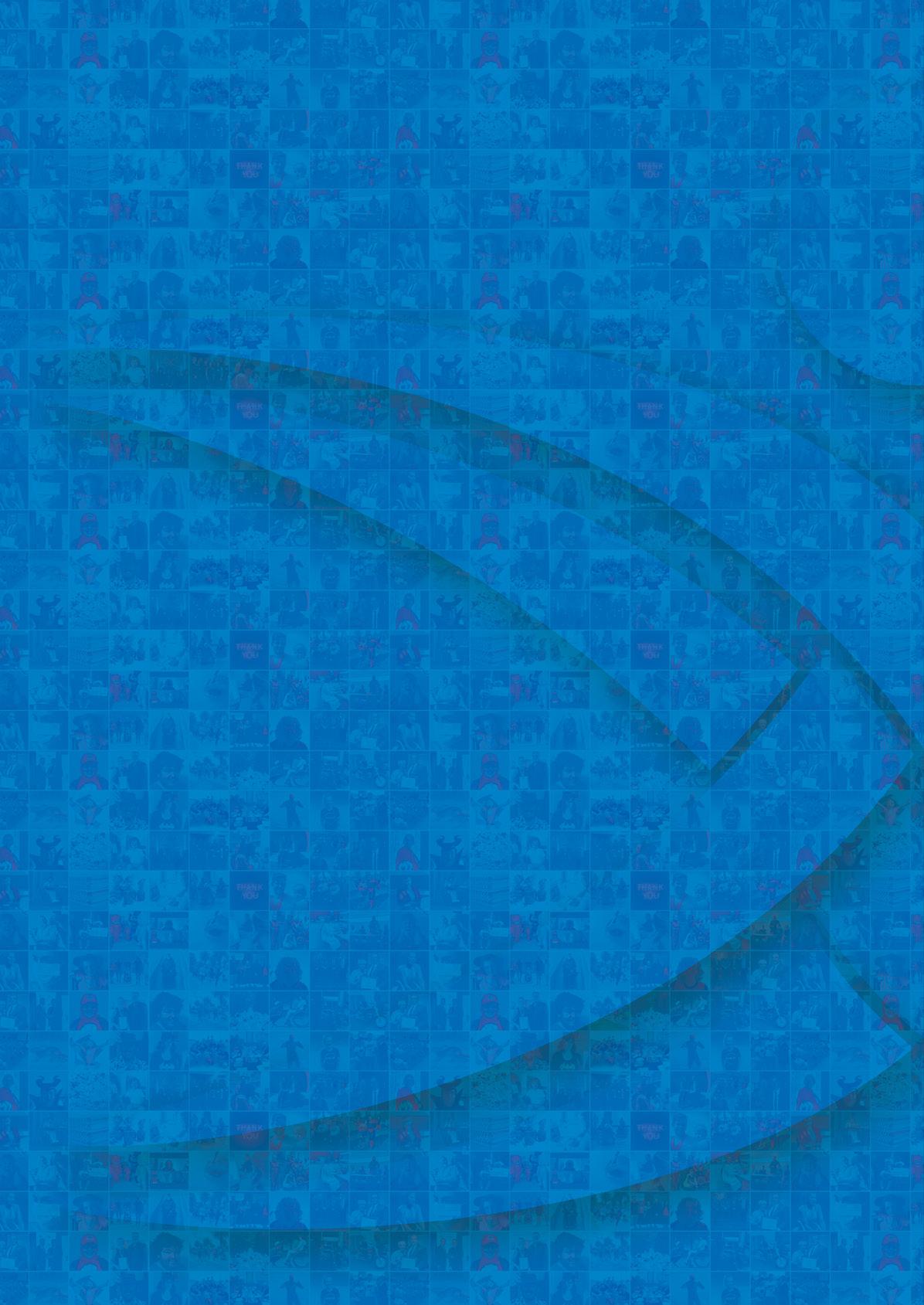



ABN: Tel: Email: Muscular Dystrophy Association Inc 111 Boundary Road North Melbourne VIC 3051 33 376 893 530 03 9320 9555 info@mda.org.au



















